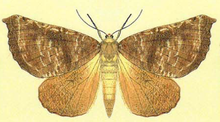
Scotorythra is a genus of moths in the family Geometridae erected by Arthur Gardiner Butler in 1883. All species of this genus are endemic to Hawaii.
Scotorythra nesiotes, the Koʻolau giant looper moth, was a moth in the family Geometridae. The species was described by Perkins in 1901. It was endemic to Oʻahu, the Hawaiian Islands.
The Hawaiian hopseed looper moth is a species of moth in the family Geometridae. It is endemic to the island of Oahu in Hawaii.
Scotorythra demetrias is a moth of the family Geometridae. It was first described by Edward Meyrick in 1899. It is endemic to the island of Hawaii.
Scotorythra euryphaea is a moth of the family Geometridae. It was first described by Edward Meyrick in 1899. It is endemic to the Hawaiian islands of Kauai, Oahu, Molokai and Maui.
Scotorythra goniastis is a moth of the family Geometridae first described by Edward Meyrick in 1899. It is endemic to the Hawaiian islands of Maui and Hawaii.
Scotorythra hyparcha is a moth of the family Geometridae. It was first described by Edward Meyrick in 1899. It is endemic to the island of Hawaii.
Scotorythra macrosoma is a moth of the family Geometridae. It was first described by Edward Meyrick in 1899. It is endemic to the Hawaiian islands of Kauai, Molokai, Maui, and Hawaii.
Scotorythra nephelosticta is a moth of the family Geometridae. It was first described by Edward Meyrick in 1899. It is endemic to the Hawaiian islands of Kauai and Oahu.
Scotorythra pachyspila is a moth of the family Geometridae. It was first described by Edward Meyrick in 1899. It is endemic to the Hawaiian islands of Kauai, Oahu, Maui, Lanai and Hawaii
Scotorythra trapezias is a moth of the family Geometridae. It was first described by Edward Meyrick in 1899.

Scotorythra paludicola, the koa looper moth, is a moth of the family Geometridae. It was first described by Arthur Gardiner Butler in 1879. It is endemic to the Hawaiian islands of Kauai, Oahu, Maui and Hawaii.
Scotorythra ochetias is a moth of the family Geometridae. It was first described by Edward Meyrick in 1899. It is endemic to the island of Hawaii.
Scotorythra epixantha is a moth of the family Geometridae. It was described by Perkins in 1901. It is endemic to the Hawaiian island of Oahu.
Scotorythra gomphias is a moth of the family Geometridae. It was first described by Edward Meyrick in 1899. It is endemic to the Hawaiian islands of Oahu, Molokai, Maui and Hawaii.
Scotorythra leptias is a moth of the family Geometridae. It was first described by Edward Meyrick in 1899. It is endemic to the Hawaiian island of Oahu.

Falcataria falcata, commonly known as the Moluccan albizia, is a species of fast-growing tree in the family Fabaceae. It is native to the Maluku Islands, New Guinea, the Bismarck Archipelago, and the Solomon Islands. It is cultivated for timber throughout South Asian and Southeast Asian countries. This tree is considered to be invasive in Hawaii, American Samoa and several other island nations in the Pacific and Indian Oceans. It reaches about 30 m (100 ft) tall in nature, and has a massive trunk and an open crown.
This page is based on this
Wikipedia article Text is available under the
CC BY-SA 4.0 license; additional terms may apply.
Images, videos and audio are available under their respective licenses.




